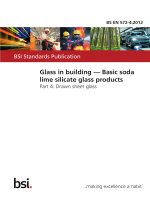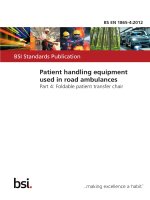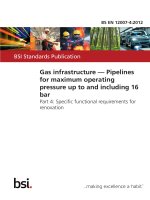Bsi bs en 61747 4 2012
Bạn đang xem bản rút gọn của tài liệu. Xem và tải ngay bản đầy đủ của tài liệu tại đây (1.07 MB, 14 trang )
BS EN 61747-4:2012
BSI Standards Publication
Liquid crystal display
devices
Part 4: Liquid crystal display modules
and cells — Essential ratings and
characteristics
BRITISH STANDARD
BS EN 61747-4:2012
National foreword
This British Standard is the UK implementation of EN 61747-4:2012. It is
identical to IEC 61747-4:2012. It supersedes BS EN 61747-4:1998 which is
withdrawn.
The UK participation in its preparation was entrusted to Technical Committee
EPL/47, Semiconductors.
A list of organizations represented on this committee can be obtained on
request to its secretary.
This publication does not purport to include all the necessary provisions of a
contract. Users are responsible for its correct application.
© The British Standards Institution 2013.
Published by BSI Standards Limited 2013
ISBN 978 0 580 75543 9
ICS 31.120
Compliance with a British Standard cannot confer immunity from
legal obligations.
This British Standard was published under the authority of the Standards
Policy and Strategy Committee on 31 January 2013.
Amendments issued since publication
Date
Text affected
BS EN 61747-4:2012
EN 61747-4
EUROPEAN STANDARD
NORME EUROPÉENNE
EUROPÄISCHE NORM
December 2012
ICS 31.120
Supersedes EN 61747-4:1998
English version
Liquid crystal display devices Part 4: Liquid crystal display modules and cells Essential ratings and characteristics
(IEC 61747-4:2012)
Dispositifs d’affichage à cristaux liquides Partie 4: Modules et cellules d’affichage à
cristaux liquides Valeurs limites et caractéristiques
essentielles
(CEI 61747-4:2012)
Flüssigkristall-Anzeige-Bauelemente Teil 4: Flüssigkristall-Anzeigemodule und zellen -Wesentliche Grenz- und
Kennwerte
(IEC 61747-4:2012)
This European Standard was approved by CENELEC on 2012-10-31. CENELEC members are bound to comply
with the CEN/CENELEC Internal Regulations which stipulate the conditions for giving this European Standard
the status of a national standard without any alteration.
Up-to-date lists and bibliographical references concerning such national standards may be obtained on
application to the CEN-CENELEC Management Centre or to any CENELEC member.
This European Standard exists in three official versions (English, French, German). A version in any other
language made by translation under the responsibility of a CENELEC member into its own language and notified
to the CEN-CENELEC Management Centre has the same status as the official versions.
CENELEC members are the national electrotechnical committees of Austria, Belgium, Bulgaria, Croatia, Cyprus,
the Czech Republic, Denmark, Estonia, Finland, Former Yugoslav Republic of Macedonia, France, Germany,
Greece, Hungary, Iceland, Ireland, Italy, Latvia, Lithuania, Luxembourg, Malta, the Netherlands, Norway, Poland,
Portugal, Romania, Slovakia, Slovenia, Spain, Sweden, Switzerland, Turkey and the United Kingdom.
CENELEC
European Committee for Electrotechnical Standardization
Comité Européen de Normalisation Electrotechnique
Europäisches Komitee für Elektrotechnische Normung
Management Centre: Avenue Marnix 17, B - 1000 Brussels
© 2012 CENELEC -
All rights of exploitation in any form and by any means reserved worldwide for CENELEC members.
Ref. No. EN 61747-4:2012 E
BS EN 61747-4:2012
EN 61747-4:2012
-2-
Foreword
The text of document 110/349/CDV, future edition 2 of IEC 61747-4, prepared by IEC/TC 110 "Electronic
display devices" was submitted to the IEC-CENELEC parallel vote and approved by CENELEC as
EN 61747-4:2012.
The following dates are fixed:
•
•
latest date by which the document has
to be implemented at national level by
publication of an identical national
standard or by endorsement
latest date by which the national
standards conflicting with the
document have to be withdrawn
(dop)
2013-07-31
(dow)
2015-10-31
This document supersedes EN 61747-4:1998.
EN 61747-4:2012 includes the following significant technical changes with respect to EN 61747-4:1998:
– 2.1 and 3.1 of EN 61747-4:1998 were deleted because these items are defined in EN 61747-1;
– 2.7.6, in 2.7, Supplementary information, of EN 61747-4:1998 was deleted because the scope of this
standard is about passive matrix monochrome liquid crystal display modules;
– the item “Gray scale: digital or analog” in 2.3.1 of EN 61747-4:1998 was changed to “Gray scale:
number” because it is more accurate;
– contrast mode: light symbol on dark background (“LOD” or “positive image”) or dark symbol on light
background (“DOL” or “negative image”) was introduced in this part of EN 61747 to replace the
description in 2.3.1 and 3.3.1 of EN 61747-4:1998.
Attention is drawn to the possibility that some of the elements of this document may be the subject of
patent rights. CENELEC [and/or CEN] shall not be held responsible for identifying any or all such patent
rights.
Endorsement notice
The text of the International Standard IEC 61747-4:2012 was approved by CENELEC as a European
Standard without any modification.
BS EN 61747-4:2012
EN 61747-4:2012
-3-
Annex ZA
(normative)
Normative references to international publications
with their corresponding European publications
The following documents, in whole or in part, are normatively referenced in this document and are
indispensable for its application. For dated references, only the edition cited applies. For undated
references, the latest edition of the referenced document (including any amendments) applies.
NOTE When an international publication has been modified by common modifications, indicated by (mod), the relevant EN/HD
applies.
Publication
Year
Title
EN/HD
IEC 61747-1
1998
Liquid crystal and solid-state display devices - EN 61747-1
Part 1: Generic specification
Year
1999
–2–
BS EN 61747-4:2012
61747-4 © IEC:2012
CONTENTS
1
Scope ............................................................................................................................... 5
2
Normative references ....................................................................................................... 5
3
Liquid crystal display modules .......................................................................................... 5
3.1
3.2
3.3
3.4
4
Principles and material used.................................................................................... 5
Modes of operation .................................................................................................. 5
Details of outline ..................................................................................................... 5
Limiting values (absolute maximum rating system) over the operating
temperature range, unless otherwise stated ............................................................ 6
3.5 Electrical and optical characteristics ........................................................................ 6
3.6 Supplementary information ...................................................................................... 7
Liquid crystal display cells (LCD cells) .............................................................................. 8
4.1
4.2
4.3
4.4
4.5
4.6
Principle and material used ..................................................................................... 8
Modes of operation .................................................................................................. 8
Details of outline ..................................................................................................... 8
Limiting values (absolute maximum rating system) over the operating
temperature range, unless otherwise stated ............................................................ 8
Electrical and optical characteristics ........................................................................ 9
Supplementary information ...................................................................................... 9
Table 1 – Electrical and optical characteristics of LCD modules .............................................. 6
Table 2 – Electrical and optical characteristics of LCD cells .................................................... 9
BS EN 61747-4:2012
61747-4 © IEC:2012
–5–
LIQUID CRYSTAL DISPLAY DEVICES –
Part 4: Liquid crystal display modules and cells –
Essential ratings and characteristics
1
Scope
This part of IEC 61747 describes the essential ratings and characteristics of LCD cells and
passive matrix monochrome liquid crystal display modules.
It does not apply to active matrix LCD cells nor to multicolour cells.
2
Normative references
The following documents, in whole or in part, are normatively referenced in this document and
are indispensable for its application. For dated references, only the edition cited applies. For
undated references, the latest edition of the referenced document (including any
amendments) applies.
IEC 61747-1:1998, Liquid crystal and solid-state display devices – Part 1: Generic
specification
3
3.1
Liquid crystal display modules
Principles and material used
Example: a TN display cell with electronic circuits and connector pins.
Where appropriate, a type of light source.
3.2
Modes of operation
3.2.1 Optical mode of operation
–
illumination mode: for example reflective, transmissive, transflective
–
gray scale: number
–
contrast mode: light symbol on dark background (“LOD” or “positive image”) or dark
symbol on light background (“DOL” or “negative image”)
3.2.2 Electrical mode of operation
–
3.3
example: static mode or multiplex mode, etc.
Details of outline
3.3.1 Material, mechanical description
–
examples: glass, plastic, metal, etc.
–
construction: for example integrated backlight, bezel structure
3.3.2 Method of connection
–
connector, flex cable or connection pins, etc.
BS EN 61747-4:2012
61747-4 © IEC:2012
–6–
3.3.3 Outline drawing and dimensions
–
overall dimensions
–
viewing area and display centre
3.3.4 Pinout table and/or connection diagram
–
type of connectors
3.3.5 Preferred or designed viewing direction
3.4
Limiting values (absolute maximum rating system) over the operating
temperature range, unless otherwise stated
3.4.1 Minimum and maximum operating temperature (T op )
3.4.2 Minimum and maximum storage temperature (T stg )
3.4.3 Minimum and maximum value of supply voltages for logic and LCD drive ( V DD -V SS ,
V DD-V EE , V EE -V SS , V O -V SS , V DD -V O )
3.4.4 Minimum and maximum value of input signal voltage (V IN )
3.4.5 Where appropriate, maximum value of backlight voltage (V BL )
3.4.6 Where appropriate, maximum soldering temperature (T sld )
–
maximum soldering time and minimum distance to module package should be specified
3.5
Electrical and optical characteristics
The following parameters should be specified in Table 1.
Table 1 – Electrical and optical characteristics of LCD modules
Reference
Characteristics
Condition at T op = 25 °C
unless otherwise
specified
Symbol
Supply voltage for logic drive
V DD -V SS
Supply voltage for LCD drive
V DD -V EE
V EE -V SS
3.5.1
Requirements
Min.
Max.
Min.
Max.
Min.
Max.
Min.
Max.
V O -V SS
V DD -V O
3.5.2
3.5.3
3.5.4
Input signal voltages
V IN
High level input signal voltage
V IH
Low level input signal voltage
V IL
Backlight voltages (where
appropriate)
V BL
Operating frequency
(where appropriate)
f op
f FRM
Frame frequency
f OSC
Oscillator frequency
3.5.5
Supply currents (without backlight)
Conditions chosen to
achieve maximum supply
current, e.g. operating
supply voltage, display
pattern, etc., as appropriate
I tot
I DD and/or
I EE
Max.
BS EN 61747-4:2012
61747-4 © IEC:2012
Reference
–7–
Condition at T op = 25 °C
unless otherwise
specified
Characteristics
Symbol
Requirements
3.5.6
High level input signal current
(where appropriate)
I IH
Max.
3.5.7
Low level input signal current
(where appropriate)
I IL
Max.
3.5.8
Operating backlight current
(where appropriate)
I BL
Max.
3.5.9
Contrast ratio
(diffused light and/or direct beam)
When the module has a
backlight system, this
system shall be used at a
specified level during the
contrast ratio
measurements
3.5.10
Luminance
(where appropriate)
Specified measuring
method and conditions
Viewing angle range
Specified definition of
viewing direction and
specified
contrast ratio
and
3.5.11
CR diff
CR dir
L
Min.
Min.
θV
Min.
Max.
θH
3.5.12
Turn-on time
Specified temperature
t on
Max.
3.5.13
Turn-off time
Specified temperature
t off
Max.
3.5.14
Transmittance (regular and/or
diffuse) (where appropriate)
Specified measuring
method and conditions
τ r and/or
3.5.15
Reflectance (regular and/or
diffuse) (where appropriate)
Specified measuring
method and conditions
ρ r and/or
3.6
τd
ρd
Min.
Min.
Max.
Supplementary information
(To be given only as far as necessary for the specification and use of the device.)
3.6.1 Angular dependence of contrast ratio
3.6.2 Switching times versus temperature
3.6.3 Timing characteristics and timing of logic voltages
3.6.4 Supply voltages sequence condition, where appropriate
3.6.5 Operating voltage range, if appropriate, as a function of temperature at specified
contrast ratio
3.6.6 Handling and operating information
3.6.7 Precautions with respect to electrostatic discharges
3.6.8 Precautions of installation: mechanical and/or electrical
3.6.9 Safety information
3.6.10 Characterization of diffuse and specular reflectance and transmittance
–8–
4
4.1
BS EN 61747-4:2012
61747-4 © IEC:2012
Liquid crystal display cells (LCD cells)
Principle and material used
Example: twisted nematic cell
4.2
Modes of operation
4.2.1 Optical mode of operation
–
illumination mode: for example reflective, transmissive, transflective
–
contrast mode: light symbol on dark background (“LOD” or “positive image”) or
symbol on light background (“DOL” or “negative image”)
4.2.2 Electrical mode of operation
Static mode or multiplex mode
4.3
Details of outline
4.3.1 Mechanical description
Example:
glass or plastic
4.3.2 Method of connection
4.3.3 Outline drawing
Dimensions and display pattern
4.3.4 Pinout table and/or connection diagram
4.3.5 LCD cell reference axis for definition of viewing angle
4.3.6 Recommended viewing direction
4.4
Limiting values (absolute maximum rating system) over the operating
temperature range, unless otherwise stated
4.4.1 Minimum and maximum storage temperatures (T stg )
4.4.2 Minimum and maximum operating temperatures (T op )
4.4.3 Maximum ambient humidity (RH)
4.4.4 Minimum and maximum atmospheric pressure outside
4.4.5 Maximum mechanical shock
4.4.6 Maximum vibration
4.4.7 Maximum acceleration
4.4.8 Maximum bending strength of the cell
4.4.9 Maximum torsional strength of the cell
dark
BS EN 61747-4:2012
61747-4 © IEC:2012
–9–
4.4.10 Maximum r.m.s. value of applied driving voltage
4.4.11 Maximum peak-to-peak value of applied driving voltage
4.4.12 Maximum d.c. voltage component of the applied driving voltage
4.4.13 Maximum soldering temperature and time, where appropriate
4.5
Electrical and optical characteristics
The following parameters should be specified in Table 2:
–
viewing direction and contrast condition;
–
electrical mode of operation.
Table 2 – Electrical and optical characteristics of LCD cells
Reference
Characteristics
Condition at T op = 25 °C
unless otherwise stated
Symbols
Requirements
4.5.1
Driving voltage
Min.
Max.
4.5.2
Driving frequency
Min.
Max.
4.5.3
Threshold voltage
At specified frequency
V th
Min.
Max.
4.5.4
Saturation voltage
At specified frequency
V sat
Min.
Max.
4.5.5
Total current: All picture
elements activated at MPX.
ratio = 1
At specified voltage and
frequency
Max.
4.5.6
Total capacitance: All
picture elements activated
at MPX. ratio = 1
At specified voltage and
frequency
Max.
4.5.7
Contrast ratio
At specified viewing direction.
Diffuse light and/or direct beam
CR dir
and/or
Min.
CR diff
Turn-on time
t on
4.5.9
Turn-off time
t off
4.5.10
Where appropriate, regular
and/or diffuse transmittance
4.5.8
τr
Max.
Max.
Min.
and/or
τd
4.5.11
Where appropriate, regular
and/or diffuse reflectance
ρr
Min.
and/or
ρd
4.6
Supplementary information
(To be given only as far as necessary for the specification and use of the device.)
4.6.1 Angular dependence of contrast ratio
4.6.2 Switching times versus temperature
4.6.3 Operating range
–
threshold voltage versus temperature;
–
operating voltage range as a function of temperature at specified contrast ratio.
Max.
– 10 –
BS EN 61747-4:2012
61747-4 © IEC:2012
4.6.4 Total picture element area
(Sum of all single picture element areas, for example, segments, symbols or dots.)
4.6.5 Handling and operation information
4.6.6 Precautions
4.6.7 Chromaticity co-ordinates
4.6.8 Uniformity characteristics
_____________
This page deliberately left blank
NO COPYING WITHOUT BSI PERMISSION EXCEPT AS PERMITTED BY COPYRIGHT LAW
British Standards Institution (BSI)
BSI is the national body responsible for preparing British Standards and other
standards-related publications, information and services.
BSI is incorporated by Royal Charter. British Standards and other standardization
products are published by BSI Standards Limited.
About us
Revisions
We bring together business, industry, government, consumers, innovators
and others to shape their combined experience and expertise into standards
-based solutions.
Our British Standards and other publications are updated by amendment or revision.
The knowledge embodied in our standards has been carefully assembled in
a dependable format and refined through our open consultation process.
Organizations of all sizes and across all sectors choose standards to help
them achieve their goals.
Information on standards
We can provide you with the knowledge that your organization needs
to succeed. Find out more about British Standards by visiting our website at
bsigroup.com/standards or contacting our Customer Services team or
Knowledge Centre.
Buying standards
You can buy and download PDF versions of BSI publications, including British
and adopted European and international standards, through our website at
bsigroup.com/shop, where hard copies can also be purchased.
If you need international and foreign standards from other Standards Development
Organizations, hard copies can be ordered from our Customer Services team.
Subscriptions
Our range of subscription services are designed to make using standards
easier for you. For further information on our subscription products go to
bsigroup.com/subscriptions.
With British Standards Online (BSOL) you’ll have instant access to over 55,000
British and adopted European and international standards from your desktop.
It’s available 24/7 and is refreshed daily so you’ll always be up to date.
You can keep in touch with standards developments and receive substantial
discounts on the purchase price of standards, both in single copy and subscription
format, by becoming a BSI Subscribing Member.
PLUS is an updating service exclusive to BSI Subscribing Members. You will
automatically receive the latest hard copy of your standards when they’re
revised or replaced.
To find out more about becoming a BSI Subscribing Member and the benefits
of membership, please visit bsigroup.com/shop.
With a Multi-User Network Licence (MUNL) you are able to host standards
publications on your intranet. Licences can cover as few or as many users as you
wish. With updates supplied as soon as they’re available, you can be sure your
documentation is current. For further information, email
BSI Group Headquarters
389 Chiswick High Road London W4 4AL UK
We continually improve the quality of our products and services to benefit your
business. If you find an inaccuracy or ambiguity within a British Standard or other
BSI publication please inform the Knowledge Centre.
Copyright
All the data, software and documentation set out in all British Standards and
other BSI publications are the property of and copyrighted by BSI, or some person
or entity that owns copyright in the information used (such as the international
standardization bodies) and has formally licensed such information to BSI for
commercial publication and use. Except as permitted under the Copyright, Designs
and Patents Act 1988 no extract may be reproduced, stored in a retrieval system
or transmitted in any form or by any means – electronic, photocopying, recording
or otherwise – without prior written permission from BSI. Details and advice can
be obtained from the Copyright & Licensing Department.
Useful Contacts:
Customer Services
Tel: +44 845 086 9001
Email (orders):
Email (enquiries):
Subscriptions
Tel: +44 845 086 9001
Email:
Knowledge Centre
Tel: +44 20 8996 7004
Email:
Copyright & Licensing
Tel: +44 20 8996 7070
Email:









